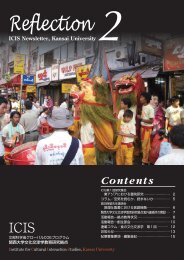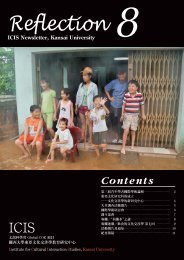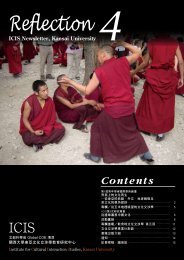English
English
English
- No tags were found...
Create successful ePaper yourself
Turn your PDF publications into a flip-book with our unique Google optimized e-Paper software.
The Establishment of a New Department for Researchon East Asian Culture: As a New Research Base for the Studyon Cultural Interaction StudiesFUJITA TakaoDeputy director, ICIS; Deputy Head,Graduate School of East Asian CulturesKansai University established the Department for Research on East Asian Culture as a new research sectionin April 2011. This new department is established to drive for the continuation and further development of theeducational organization formed as a COE program, “The formation of basis for the research and education of thestudies on cultural interaction in East Asia” which will end in March 2012.As a training unit for global COE program, Kansai University hasalready established the course specialized on the studies of culturalinteraction in April 2008, by rearranging the department of literaturestudies. As this course met the year of completion in March 2010when the first Doctor of this curriculum was born, it was decided tomake this course independent from the department of literaturestudies and merged into newly established department of research onEast Asian instead. By so doing, we intend to improve the activitiesof research and education for the studies on East Asian culture whichis the specialty of Kansai University as well as to develop the featureof the international hub for research and education which wascultivated within the global COE program.We primarily succeed the former curriculum arranged by thedepartment of literature studies. In addition to the old program,however, we set the following three new research areas to provide thefoundational viewpoints for the study on East Asia and arrange thecourse programs accordingly; “Language and Images in East Asia”,“Ideas and Structure in East Asia” and “History and Movement inEast Asia”.Research students in this newly established department will focuson substantial themes for their own research projects from one ofof Literature. Also we have received 15 students for the precedingcurriculum and 7 research students for the following curriculum bothfor PhD course on this April in the first year of the department. 11students which are about the half of all the students in our departmentcome from foreign countries. In comparison with the situation of theperiod when the department of the research on literature was incharge, it remains the same that many foreign students are registered.Adding the number of students who had been enrolled previously, wehave 56 postgraduate students both of preceding and followingcurriculums which is quite a large number for a solo department.The term of “the cultural interaction” was not generally knownwhen our Kansai University started to advocate this new field ofstudy. Later, however, Korea Maritime University at Busan whichwas chosen for a program similar to COE called HK HumanityKoreafounded an educational program for cultural interactionstudies. The Department of Literature at Sophia University alsoestablished the course for cultural interaction studies in April 2011.Language and Imagesin East AsiaIdeas and Structurein East AsiaHistory and Movementin East AsiaWelcome Party for New Students 2011Three research areas in the department of t East Asian cultural Studiesthese three areas and attempt to develop their own studies by crossingborders of academic fields as well as regions for the research.The department of research on the East Asian culture started withseven members consisted of the Head Manager TAO Deming, theDeputy Managers UCHIDA Keiichi, NIKAIDO Yoshihiro, FUJITATakao, and the Promoters of Project AZUMA Juji and MATSUURAAkira, in addition to Prof. NAKATANI Nobuo from the DepartmentEach university, though attempting to do individually differenteducation and research, adopted the term “cultural interaction” in<strong>English</strong>, which could be a sign of the expansion and fixation of thecultural interaction studies as a new field of research. Under thesecircumstances, the role of this research base as a pioneer of the fieldwould increase its importance more than ever before. We hope tohave still more understandings and cooperation from all interestedparties.












